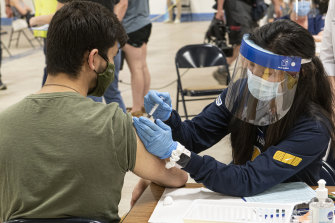Washington: The US is recommending a “pause” in administration of the single-dose Johnson & Johnson COVID-19 vaccine to investigate reports of potentially dangerous blood clots.
In a joint statement Tuesday, the Centres for Disease Control and Prevention and the Food and Drug Administration said they were investigating clots in six women that occurred in the days after vaccination. The clots were observed along with reduced platelet counts – making the usual treatment for blood clots, the blood thinner heparin, potentially “dangerous.”
A Kent State University student getting his Johnson & Johnson COVID-19 vaccination in Ohio.Credit:AP
More than 6.8 million doses of the Johnson & Johnson vaccine have been administered in the US, the vast majority with no or mild side effects.
US federal distribution channels, including mass vaccination sites, will pause the use of the Johnson & Johnson shot, and states and other providers are expected to follow. The other two authorised vaccines, from Moderna and Pfizer, are not affected by the pause.
CDC’s Advisory Committee on Immunisation Practices will meet on Wednesday, local time, to discuss the cases and the FDA has also launched an investigation into the cause of the clots and low platelet counts.
“Until that process is complete, we are recommending a pause in the use of this vaccine out of an abundance of caution,” Dr Anne Schuchat, Principal Deputy Director of the CDC and Dr Peter Marks, director of the FDA’s Center for Biologics Evaluation and Research said in a joint statement.
They are recommending that people who were given the Johnson & Johnson vaccine who are experiencing severe headache, abdominal pain, leg pain, or shortness of breath within three weeks after receiving the shot contact their health care provider. Officials say they also want to educate vaccine providers and health professionals about the “unique treatment” required for this type of clot.
Australia this week ruled out buying the Johnson & Johnson vaccine as it was too similar to the AstraZeneca vaccine, which has also been restricted for use in Australia and overseas because of blot clotting concerns.
The Johnson & Johnson vaccine received emergency use authorisation from the FDA in late February with great fanfare, with hopes that its single-dose and relatively simple storage requirements would speed vaccinations across the country. It was also identified as the best prospect for the Quad alliance’s plan to distribute vaccines to developing nations in Asia and the Pacific.
However, the shot only makes up a small fraction of the doses administered in the US as Johnson & Johnson has been plagued by production delays and manufacturing errors at the Baltimore plant of a contractor.
Last week the drugmaker took over the facility to scale up production in hopes of meeting its commitment to the US government of providing about 100 million doses by the end of May.
Until now concern about the unusual blood clots has centred on the vaccine from AstraZeneca, which has not yet received authorisation in the US Last week, European regulators said they found a possible link between the shots and a very rare type of blood clot that occurs together with low blood platelets, one that seems to occur more in younger people.
The European Medicines Agency stressed that the benefits of receiving the vaccine outweigh the risks for most people. But several countries have imposed limits on who can receive the vaccine; Britain recommended that people under 30 be offered alternatives.
But the Johnson & Johnson and AstraZeneca vaccines are made with the same technology. Leading COVID-19 vaccines train the body to recognise the spike protein that coats the outer surface of the coronavirus. But the Johnson & Johnson and AstraZeneca vaccines use a cold virus, called an adenovirus, to carry the spike gene into the body. Johnson & Johnson uses a human adenovirus to create its vaccine while AstraZeneca uses a chimpanzee version.
AP
Most Viewed in World
From our partners
Source: Read Full Article
